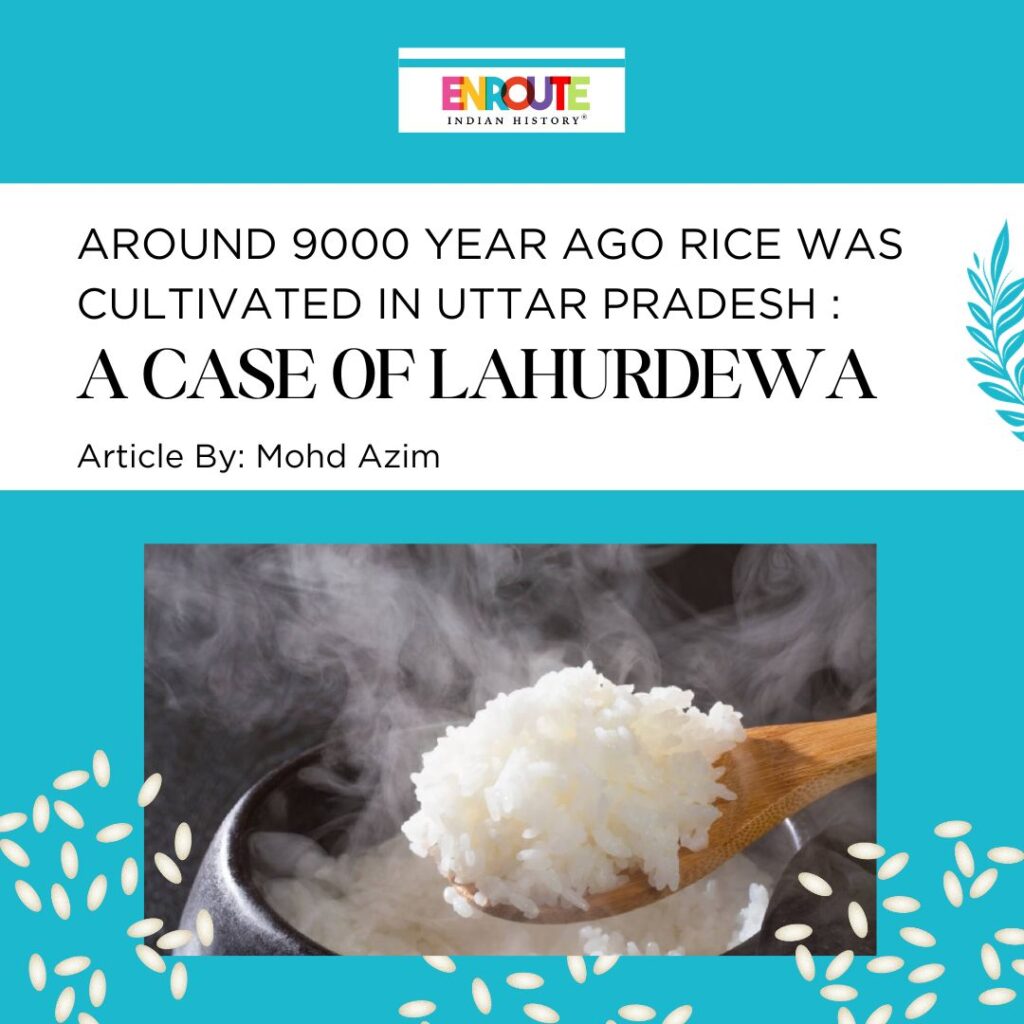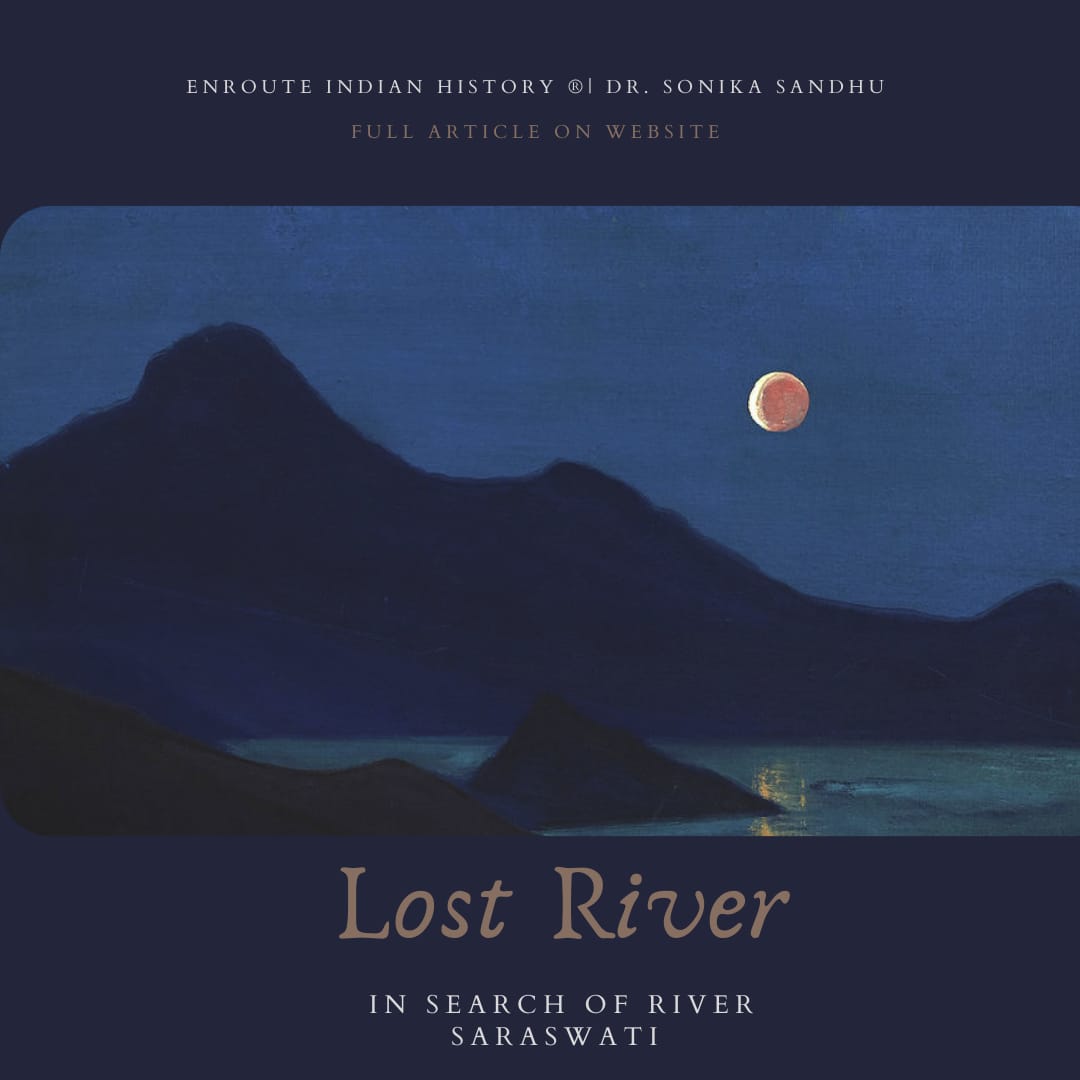Finding Earliest Evidence of Rice Cultivation, The Site of Lahuradewa
- enrouteI
- October 20, 2023

Rice, one of the world’s most vital crops, has a history that stretches back millennia. Its origins can be traced to various regions in Asia, and archaeological discoveries have played a crucial role in shedding light on the early cultivation of this essential grain. One such discovery that stands out in the annals of history is Lahuradewa. The Lahuradewa archaeological site in Sant Kabir Nagar district, Uttar Pradesh is located adjacent to the Lahuradewa lake. It is significant to note that the lake sediments and archaeological sites at Lahuradewa both provide information on environmental changes and anthropogenic activity for the last 10,000 years.
The Lahuradewa archaeological site is a testament to the early farming traditions in India. The settlement here marked the beginning of a phase where ceramic and non-metallic materials emerged, complemented by rice cultivation.
From Ceramic to Rice Cultivation: Tracing the Ecofactual Evidences at Lahuradewa
When researchers dug at Lahuradewa, they found evidence of different periods in history. First, they discovered old pottery and animal remains, like bones and a tortoiseshell. What’s important is that they also found pieces of burned rice, showing that people here were growing rice, probably a kind called Oryza sativa. This marked the start of a time when people lived in one place and grew crops like rice.
The researchers found copper tools and later rusted iron objects, like sickles. The ground they dug into was about 80 cm thick and had pottery from the earlier time. They also found things like floors made from earth, lumps of clay with reed and straw marks, and places where they made fires.
Ancient Indian Settlement and Rice Cultivation
Experts and scientists have been arguing for a long time about where and when people first started growing rice. Some said it was in South China, others thought it was in the Yangtze River valley. South Korea even had its ideas, but those were proven wrong. In 2016, new research pointed to rice fields in China’s Yangtze Valley around 8,400 years ago.
A big piece of this puzzle was a study by Thakur, who found evidence of rice farming in India about 9,250 years ago. This lines up with what others found using tiny structures in plants called phytoliths. These structures stick around long after the plants are gone. Thakur’s work gives us a solid date, and now he and his team want to learn more about the climate and environment around 11,000 years ago when people first settled in India.
Their goal is to figure out if Indian settlements happened at the same time as in other parts of the world and if people might have come to India from somewhere else. By digging into this ancient history, Thakur and his team hope to tell us more about the fascinating history of rice farming and how it shaped human society.
Diatom Analysis
For a long time, scientists used something called phytoliths to learn about the history of rice farming. But now, they’ve found a more powerful tool: diatoms. Diatoms are tiny living things found in water all over the world, and they’re essential because they produce about 20% of the Earth’s oxygen. In rice fields, diatoms leave behind a special mark that tells us about the water levels that change with the seasons.
Diatoms live in different types of water, like lakes and rice fields. There are four main types: planktic diatoms float in lakes, benthic diatoms grow on the bottom, paddy-field diatoms love waterlogged rice fields, and anthropogenic diatoms thrive in water polluted by humans. Over time, the number and types of diatoms in a lake change in layers based on the lake’s conditions. When a lake gets bigger, there are more planktic diatoms, and when it gets smaller, benthic diatoms become more common. When there are rice fields nearby, paddy-field diatoms get washed into the lake. And if there’s pollution, anthropogenic diatoms grow more.
One example is Lahuradewa Lake, which is like many other lakes in the Gangetic Plain. It’s not very deep and has flat areas used for farming. When the monsoon season comes, the lake gets bigger, and people use the flat parts to grow rice. They harvest the rice in October when the lake gets smaller again. Sometimes, during floods, tiny things like diatoms, phytoliths, burned plant pieces, and pollen from rice get washed into the deeper parts of the lake and settle at the bottom. By studying these diatoms, scientists can learn a lot about the history of rice farming, where it started, and how it influenced human history.
Insights from Lahuradewa Lake
A team of researchers studied 28 samples from the bottom of Lahuradewa Lake to learn about the history of rice farming. They found that around 10,600 to 9,900 years ago, the lake was shallow. Then, it got bigger and deeper, which lasted until about 7,000 years ago. What’s interesting is that around 9,250 years ago, they saw lots of paddy field diatoms in the lake. This suggests that people in this area were trying to grow rice at the same time as people in China, but without the pollution that often comes with farming.
The place they studied is in the Gangetic plains, and it has changed a lot over time because of things like rivers, earthquakes, and climate. This area is like a gold mine for studying old plants because it’s where early human settlements first appeared. The fact that Lahuradewa Lake is close to the Lahuradewa excavation site, where researchers are looking at early farming and human settlements, makes this study even more important.
Thakur, the lead researcher, said that understanding this ancient information helps us figure out how people in the past dealt with good and tough conditions. This knowledge also helps us make better predictions about future climate changes and how people will react to them. In the end, the study shows that rice farming in India happened at the same time as in China, and it gives us proof that rice was grown independently in India.
RICE : THE VITAL GRAIN
Rice holds a position of immense importance in the global landscape, touching upon agriculture, nutrition, culture, and economics. It serves as a linchpin for food security, sustaining over half of the world’s population, with a significant presence in Asian diets. Its nutritional value extends beyond being a source of carbohydrates, offering essential vitamins and minerals. Beyond sustenance, rice is steeped in cultural significance, playing pivotal roles in religious ceremonies and daily traditions, symbolizing purity, fertility, and prosperity. Its economic importance cannot be understated, driving employment and livelihoods in regions devoted to rice cultivation. Biodiversity, environmental impact, trade, and research make up the multifaceted importance of rice, intertwining it with global sustainability and food security.
Rice manifests in various types and varieties, such as long-grain, short-grain, basmati, and jasmine, each contributing distinct flavors and textures to culinary traditions worldwide. Alongside this diversity, rice brings health benefits. It is an excellent energy source, low in fat, and naturally gluten-free, catering to a broad array of dietary needs. Brown rice, in particular, enriches diets with fiber and antioxidants, supporting digestive health and overall well-being. Rice’s role in providing satiety and facilitating balanced diets further underlines its significance as a foundational staple in global nutrition.
In the tranquil depths of Lahuradewa Lake and the ancient whispers of the Lahuradewa archaeological site, the history of rice cultivation unfolds like an intricate tapestry. As we delve into the annals of time, we unearth the seeds of knowledge, sown by our ancestors over 9,000 years ago. Rice, the grain that sustains nations, was cultivated here, in parallel with the cradle of Chinese civilization, marking an independent chapter in the rich story of humankind’s journey.
These echoes from the past not only tell the tale of rice’s humble beginnings but also offer us invaluable lessons in resilience and adaptation to changing environments. With each grain of knowledge, we paint a clearer picture of our ancestors’ responses to the world around them, and in doing so, we glean insights that may guide us as we navigate the challenges of our future.
References –
Thakur, Biswajeet, et al. “Paddy Cultivation During Early Holocene: Evidence From Diatoms in Lahuradewa Lake Sediments, Ganga Plain.” Current Science, vol. 114, no. 10, Indian Academy of Sciences, May 2018, p. 2106. https://doi.org/10.18520/cs/v114/i10/2106-2115.
Tamak, Jagdish. Palaeoethnobotany at Lahuradewa : A Contribution to the 2nd Millennium BC Agriculture of the Ganga Plain, India. 2011, www.semanticscholar.org/paper/Palaeoethnobotany-at-Lahuradewa-%3A-a-contribution-to-Tamak-Mahavishnan/9bf2eaec994c81269540887687345b34e1900e9e.
Ramesh, Sandhya. “India’s Rice History May Not Have Had Anything to Do With China.” ThePrint, 6 June 2018, theprint.in/science/indias-rice-history-may-not-have-had-anything-to-do-with-china/66738.
“The History of Lahuradewa.” https://prehistoryofindia.wordpress.com/2019/11/15/the-history-of-lahuradewa/, Nov. 2019, prehistoryofindia.wordpress.com/2019/11/15/the-history-of-lahuradewa.





















